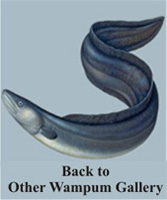|
|
Photographs (left to right): St Thomas, Pennsylvania; Rochester Lower Gorge, Rochester, New York; St Thomas, Pennsylvania
Wampum Belt Archive
Mi'kmaq Nation - Vatican Belt

Vatican Ethnographic and Missionary Museum, Vatican City, Rome, Italy (VEMM u)
The Concordat Belt ca. 1611


(L to R: My brother Robert Hamell and his sons Jeremiah and Joshua)
Reproduction
I am indebted to Tara Prindle for loaning me her graphic layout of this belt.
Original Size: |
Beaded Length: est. 79.0 inches. Width: 4.5 inches. Beaded Length: 646 rows. Beaded Width: 15. |
Reproduction: |
Beaded Length: 105 inches. Width: 6.75 inches. Length w/fringe: 129 inches. |
Beads: |
Total beads: 9,690 |
Materials: |
Warp: Deer leather. Weft: Artificial sinew |
The Mi’kmaq (also spelled Micmac, Miigmaq, Mi’gmaq, Mìgmaq) are a First Nations people, indigenous to the northeastern region of New England, Canada’s Atlantic Provinces, and the Gaspé Peninsula of Quebec. The nation has a population of about 40,000 (plus 21,429 in the Qalipu First Nation), of whom nearly 11,000 speak the Míkmaq language.
The Mi’kmaq historically referred to themselves as Lnu or Linuaki, but used the term níkmaq (my kin) as a greeting. The French initially referred to the Míkmaq as Souriquois or (through English) “Mickmakis”. The British originally referred to them as Tarrantines.
The Mi’kmaq were members of the Wapnáki (Wabanaki Confederacy), an alliance with four other Algonquian-language nations: the Abenaki, Penobscot, Passamaquoddy, and Maliseet. The allied tribes ranged from present-day New England in the United States to the Maritime Provinces of Canada.
Description:
The Vatican Wampum Belt: http://tribes.tribe.net/realdealhistory/thread/031ae494-9587-4665-a5cb-99b5513f9496 Left to right
Church Agreement
1. At the end (left) of the wampum is the symbol for the twelve apostles of Niskam's child, Jesus Christ, who have spread God's message to the world.
Church Built on the Rock
2. The second symbol is the church, built upon the rock, St. Peter. The symbol of the church with an open window represents the principle that each Mi'kmaq had the right to accept or reject Catholicism through individual choice. Also, the open church must accommodate the Mi'kmaq language and culture.
Mi'kmaq Hieroglyphic Script
3. In the Ancient Mi'kmaq Hieroglyphic script, the council freely grants forever to the Catholic Church the right to build and keep churches on the Mi'kmaq lands, as well as the privilege that its priests may conduct masses and teach in the Mi'kmaq language.
The Keys of St. Peter
4. The keys of St. Peter represent the grand chief's recognition of the pope's spiritual and political authority in the world, including Mi'kmaqik. The keys are placed on the belt to symbolize Vatican protection of the Mi'kmaq nation and it's people under the authority of god. No power on earth could attempt to harm Mi'kmaq Catholics.
Black Robe and Mi'kmaq
5. The fifth symbol, the black robe, represents the priest. This figure, together with the Mi'kmaq figure holding the cross, illustrates the union of the church and the Mi'kmaq Grand Council. Each are equal and sacred in the alliance. The small bundle the Mi'kmaq holds represents the retention of the Mi'kmaq sovereignty and cultural rights within the alliance. Mi'kmaq cultural rights will be especially accommodated within the church.
The Crossed Spears
6. The sixth symbol, the crossed spears, represents the grand chief's promise to plant Christ's lessons of wisdom, truth, and forgiveness in the hearts of all Mi'kmaq, Like the spears stuck in the ground.
The Pipe and the Battle Axe
7. The seventh symbol, the peace pipe and the battle axe, reflects the grand chief's pledge to follow the path of brotherly love, and to protect those who join in the holy alliance.
The Twelve Apostles
8. The left side represents the agreement of the Roman Catholic Church with Mi'kmaq Grand Council. The markings on the left represent the seven Mi'kmaq districts. This means that all seven districts joined in the concordat with the holy father.
Note should be made of the 2 pieces of coarse twine that are attached to the belt. These are short pieces of either course twine or some rough fiber that now remain on the belt, but their function or functions are not known. One is 15 mm long, passes through the belt and has a knot on the obverse side. A similar short piece pierces the belt between row 1 and row 2, close to center of 4B zigzag. This placement of a possible attachment between the kneeling figure and the crossed spears may be significant, but no suggestions can be made at this time. Note also should be made that there are varying degrees of damage and bead loss from this belt (Becker, 2007)
Oral tradition stated this could be the oldest known wampum belt given as early as 1610. The Vatican belt was made at the Lac Des Deux Montagnes (Lake of Two Mountains) missionary community (Montreal) in 1831 according to Dr. Giovanni Pizzorusso.


The Treaty provided that:
· the Mi'kmaq Nation and the United States would aid one another against any enemy, including Great Britain
· the Mi'kmaq would not assist British troops or trade as long as hostilities continued
· the States and Mi'kmaqs pay restitution for any injuries to each other
· disputes between the Mi'kmaq and the United States would be settled peacefully
· the Mi'kmaq would provide troops to General Washington
· the Grand Council urge the Passamaquoddy and other allies to agree to the Treaty, and
· Massachusetts provide a trading post for the Mi'kmaq.
James Bowdoin the President of the Massachusetts Council, stated that, "the United States now forms a long and Strong Chain, and it is made longer and stronger by our Brethren, the Mi'kmaq Tribes, joining with us; and may Almighty God never suffer this Chain be broken."
For the mutual defense of the United States, the Mi'kmaq and their allies formed the American Battalion. In the fall of 1776, under American Colonel Jonathan Eddy, they attacked the British Fort Cumberland in Nova Scotia. Early in 1777, they prepared for the American invasion of Nova Scotia. In the meantime, they launched raids on British shipping and trading posts, and aided the American forces when called upon by the United States. They effectively secured the Maine border against British attack.
The Continental Congress of 1777 commissioned John Allan as Superintendent of Indian Affairs for the Eastern Department and gave him instructions respecting trade with the Mi'kmaq. In the Summer of 1778, the Mi'kmaq affirmed their alliance with the United States and France. France, an old ally of the Mi'kmaq, entered the Revolution as the first European ally of the United States. On July 14th, 1778, Colonel Allan received a message from the Grand Council which consisted of three strings of Wampum, one from the Civil Chiefs, one from the Warriors to the Warriors of the United States, and one for the King of France, welcoming him into their country, to be an ally of the United States.
In July of 1780,the Mi'kmaq and their allies sent a large Wampum belt to the Congress in Philadelphia, and to the King of France, "as a pledge of their friendship and fidelity". Despite military and political pressure from the British and the Western Tribes, who warned them to withdraw from supporting the United States, "or be treated like an enemy", the Mi'kmaq refused to dissociate themselves from the United States. The Wampum belt was presented to the Provincial Congress and to the French Consulate in Massachusetts by Allan's representative. Massachusetts forwarded the belt to the Continental Congress.
After the Revolution,the Constitution of the United States gave Congress the exclusive authority to implement pre-1789 Treaties made under the authority of the United States. Thus the 1776 Treaty was transferred to the Federal Government. In addition, Congress was given authority to regulate commerce with foreign nations and Indian tribes.
The United States and Great Britain agreed that the Mi'kmaq had the free right to cross the international boundary between British North America(now Canada)and the United States with out hindrance in the Jay Treaty of November 19, 1794 and the Treaty of Ghent of December 24, 1814.
The Grand Council and the Mi'kmaq continue to honor their Treaty with the United States by serving in the armed forces of the United States without regard to citizenship and continue to regard themselves as rightfully free to travel and work in the United States.
In 1976, Governor Dukakis declared in an Executive Order that the Commonwealth of Massachusetts has long maintained special relations with the Native Americans of the region, has never ceased to recognize the Mi'kmaq Treaty or the Grand Council and continues to preserve their special treaty status.
In 1981, the State Legislature also affirmed the special status of the Mi'kmaq by including their children among those American Indians eligible for scholarships, tuition and fee waivers in public state institutions of higher learning.
- Taken from an address by Mi'kmaq Grand Captain Alex Denny
to the Massachusetts House of Representatives, June 24,1987;
during the historic renewal ceremony of the Watertown Treaty of 1776.
Stolle, Nickolaus (2016): ex Collegium De Propaganda FIde, Rome, gift to Pope Gregory XVI from the Mohawks of Oka (Lac des Deux Montaignes) in 1831.
Reference:
Becker, Marshall J. 2007. The Vatican Wampum Belt: An Important American Indian Artifact and its Cultural Origins and Meaning within the Category of "Religious" or "Ecclesiastical-Convert" Belts. http://mikmawey.uccb.ns.ca/wampum.html
Orange County Catholic News. 2014. http://www.occatholicnews.com/vatican-exhibit-in-oc/
Prindle, Tara. 2014.
Stolle, Nickolaus. 2016. Talking Beads: The history of wampum as a value and knowledge bearer, from its very first beginnings until today. Hamburg, Germany. ISSN 1437-7837
Tribal Art. 2014. http://www.tribalartsociety.com/?lg=en
The Vatican Wampum Belt. http://www.scribd.com/doc/67102612/The-Vatican-Wampum-Belt-Treaty
The Vatican Wampum Belt Treaty Online. Vatican Belt PDF Download
 |
 |
 |
 |
 |
 |
 |
 |
|---|